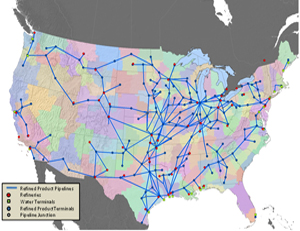
Estimating the impacts of damaging events through modeling of crude oil and refined products transportation

The system-level performance of the liquid fuels sector during a disruptive event is a result of complex interactions involving market dynamics and operational decisions at individual facilities. These interactions are sufficiently complex that forecasting performance is difficult without computer models that represent the most important aspects of sector operations.
The National Transportation Fuels Model (NTFM) is a network model of the transportation of crude oil and refined products in the lower 48 states and the portions of Canada that supply crude oil to the United States. It provides a methodology for estimating the impacts of events that damage or disrupt liquid fuels infrastructure. Disruption impacts depend on which components of the infrastructure are damaged, the time required for repairs, and the position of the disrupted components in the fuels supply network. It is the role of the NTFM to discover and simulate the system-level adaptive responses employed to mitigate fuel shortages, such as the options to receive fuels by alternative transportation routes, to use of surge capacities, or to draw down inventories. These adaptive responses are market-driven – NTFM algorithms include a simplified representation of market dynamics and the resulting decisions made by consumers and facility operators, as well as the physical constraints imposed by the capacities and connectivity of individual infrastructure facilities (e.g. pipelines, refineries, terminals).
Impact estimates have two fundamental steps: defining the stressing event and estimating the event’s impact in terms of a performance metric. The disruptive event’s definition includes damage to supporting infrastructure such as electric power. The metric used to evaluate the level of impact is how well the liquid fuels sector performs its mission of providing fuel to consumers during and after a stressing event. Measures of decrease in fuel consumption include duration, magnitude, and geographic extent of fuel shortages.